Hisham's Palace › Roman Wall Painting » Ancient origins
Articles and Definitions › Contents
- Hisham's Palace › Ancient History
- Roman Wall Painting › Antique Origins
Ancient civilizations › Historical and archaeological sites
Hisham's Palace › Ancient History
Definition and Origins
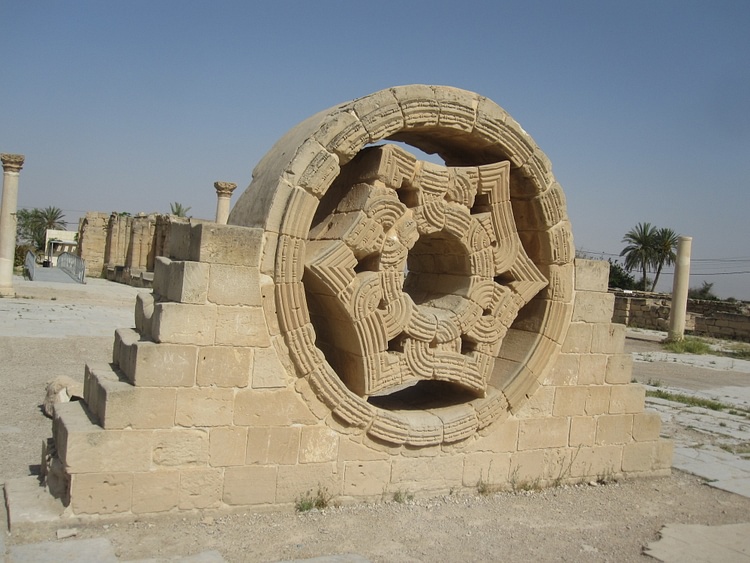
Hisham's Palace at Khirbat Al Mafjar (the ruins of Mafjar) is an Umayyad structure that is listed among the last of the surviving antiquities of Romans and Byzantines. It was built by Walid Ibn Yazid in 734 CE near Jericho in the Jordan Valley during the reign of Caliph Hisham Ibn Abdelmalik between 724-743 CE. This palace is among the last of the very sophisticated desert palaces in the region and is renowned for its elaborate mosaics, stucco carvings and overall sculptural magnificence. It is famous for the decorations that represent illustrations belonging to early Islamic classical art. It was built mostly from sandstone and baked brick.
DIMENSIONS & LAYOUT
The plan and location suggest it may have been a khan or guest-house. The significance of this building can be seen in various levels. The geometrical pattern of both plan and elevation creates a sense of harmony and this unity is highly emphasized in the rich décor of colorful mosaics. This design actually reflects the luxurious standard of living and the political and tribal power of the Umayyads. The structural aspects of Khirbet al-Mafjar reveal an elaborate use of vaulting system involving the dome and barrel vaults.
Khirbat Al Mafjar is a large complex measuring about 265 m and it includes three major areas consisting of a two-storied palace, a mosque accompanied by a small courtyard, a bath including an audience hall (throne room), all of which are enclosed by an outer wall. To the east, bordering the length of the site extends a forecourt with a centrally featured fountain.The main gate of the compound is centrally located on the southern façade of the palace and is flanked by two solid buttress towers on either edge of the front of the structure. However, other Umayyad desert palaces tend to conform to a single type as their central feature is an enclosure roughly 70 m. per side - a common Umayyad measurement unit based on a multiple of the Roman foot.
HISHAM'S PALACE IS A LARGE COMPLEX MEASURING ABOUT 265 M & IT INCLUDES THREE MAJOR AREAS CONSISTING OF A TWO-STORIED PALACE, A MOSQUE ACCOMPANIED BY A SMALL COURTYARD & A BATH.
Like the plans of other Umayyad residences, Khirbat Al Mafjar shows some strange irregularities. For example, the axis of the porch and those of the entrance hall are not parallel, and neither are they produced westwards. These axis fall on the centre of the opposite side of the courtyard or align with the axis of the central room within. The porch itself is far from the east side. The overall plan closely resembles a square and can convince the viewer that the builders intended to make it as one.
Khirbat Al Mafjar contributes to our general understanding of early Muslim architecture. There is a genetic connection between a specific architectural feature of Khirbat Al Mafjar and of the buildings that came earlier, which can be inferred from the porches of the secular structures. The monumental projecting porch does not occur in mosque architecture until the Great Mosque of Mahdia, built about 916 CE and have long since disappeared. However, the porches at Khirbat Al Mafjar suggest that they must have existed earlier.
PALACE RESIDENTIAL AREA
The palace residential area is composed of large and small rooms facing inwards onto a courtyard. The initial impression of the plan represents the essence of a residential building, reflecting in its careful arrangement of rooms within an outer wall the most ancient Oriental concept of what a house should be - a zone enclosed within continuous walls. The house plan gives the impression that it was harem, a chamber reserved for the family.

Model of Hisham's Palace
BATH HALL
The bath hall at Khirbat Al Mafjar is the most lavishly decorated building. It is well-known to historians of Islamic art through the excavation and reconstruction of its layout by Robert Hamilton, who gives life and meaning to the different elements of its architecture and decoration. This bath hall seems to have served as an appropriate arena for the extravagant life by Al Walid II, as described by his biographers and which eventually led to his assassination. The bath complex contains one of the earliest and most famous and unique mosaic panels from the classical period of Islamic architecture representing a lion attacking a gazelle underneath a tree.
The bath or Hammam, located about 40 m north of the palace site, is the second largest building. The ruins reveal that the buiding used to be a bath as they are comprised of irregular-sized mounds with fragments of brick, carved stone and rubble scattered here and there. It appears that construction of the bath preceded that of the palace. Moreover, it is not unusual to have a bath located in a remote part of the palace as two other Umayyad baths, Hammam as Sarakh and Qusayr' Amrah were also built in an isolated area with no residential buildings located in the nearby vicinity. In the elaboration of architecture and ornament, the bath at Al Mafjar was equally, if not better, developed than the palace itself.
MOSAICS
Khirbat Al Mafjar was adorned in different ways with mosaics, stucco carvings and sculptures embellishing mostly the Palace entrance hall, the bath and the audience hall. Geometrical and figural mosaics cover the floor of the bath resembling carpets and the walls are covered with fine painted stucco. The floor is covered by two mosaic panels - one rectangular with a geometric design and the other an arched panel filling the slightly elevated floor of an apse. The arched panel has the representation of the lion attacking the gazelle. It is the only mosaic panel in the complex that has a figural motif, suggesting that this motif had a symbolic meaning of particular significance. The mosaic is thought to be symbolic of the advent of peace that follows the triumph of Islam.
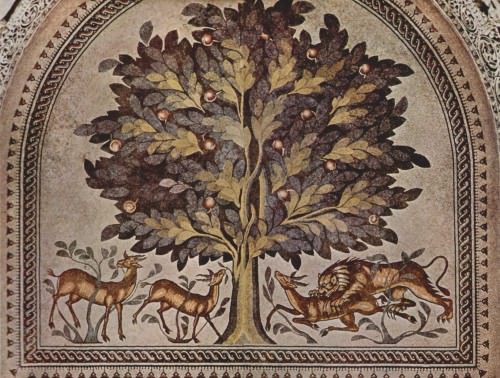
Mosaic, Khirbat Al Mafjar
At the centre of the mosaic panel is a large tree bearing fruit that look like pomegrantes. The foliage of the tree seems to grow on both sides from two vertical parallel trunks connected by a smaller branch. The viewer looking into the room can see the lion attacking a gazelle underneath the tree on his right side.
In decorative terms, Umayyad palaces contain the most powerful forms of architecture and décor extending from mosaic floors to walls lined with decorated tiles and stucco. Much of the visual attraction of Umayyad architecture and its decoration is the manner in which the old forms were recombined, rejuvenated and recreated by the new culture that was endowed with immense wealth and searching for an individualistic form of art. The paintings of Khirbat Al Mafjar are also a remarkable document not only to record the existence of a tradition of painting in pre-Islamic Syria and Palestine, but also to show that there were enough monuments from earlier times in that area to provide evidence of the elements of synthesis of eastern and western styles and of a juxtaposition of older and more recent ones.
Roman Wall Painting › Antique Origins
Ancient Civilizations
The interiors of Roman buildings of all description were very frequently sumptuously decorated using bold colours and designs. Wall paintings, fresco and the use of stucco to create relief effects were all commonly used by the 1st century BCE in public buildings, private homes, temples, tombs and even military structures across the Roman world. Designs could range from intricate realistic detail to highly impressionistic renderings which frequently covered all of the available wall space including the ceiling. Subjects could include portraits, scenes from mythology, architecture using trompe-l'oeil, flora, fauna and even entire gardens, landscapes and townscapes to create spectacular 360° panoramas which transported the viewer from the confines of a small room to the limitless world of the painter's imagination.
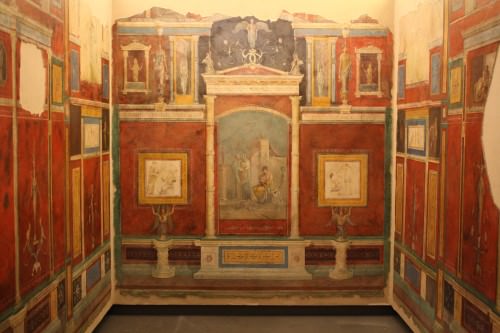
Roman Frescoed Room
MATERIALS & TECHNIQUES
Wall paintings were created using a painstaking build up of various layers of material. The optimum process is described by both Vitruvius and Pliny the Elder. First, a rough coat of mortar is applied to the surface, sometimes three layers thick and composed of lime and sand (or volcanic pozzolana). Next, a further three coats were added, this time using a mixture of lime and fine crushed marble to give a smoother finish and then glass, marble and cloth were used to polish the surface and prepare it for painting. Colours were added when the surface was still wet (fresco) but details might also be added to a dried surface (tempera). If the surface were wood then colours might be first dissolved in wax and added to the wall using a spatula.
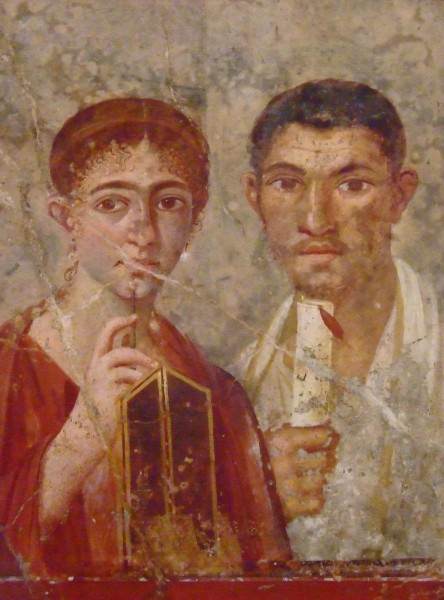
Fresco, Pompeii
DESIGNS
Roman wall painters (or perhaps their clients) preferred natural earth colours such as darker shades of reds, yellows and browns. Blue and black pigments were also popular for plainer designs but evidence from a Pompeii paint shop illustrates that a wide range of colour shades was available. All kinds of scenes were painted on walls which were often sketched in outline first using red ochre. Initially influenced by Hellenistic artists, scenes from Greek mythology were particularly popular and especially those involving Dionysos. Other popular subjects included gladiator contests, landscapes, buildings, gardens and still-lifes. Decorative motifs appear again and again, for example, tripods, fruit, foliage, ribbons, candelabra, theatre masks and architectural elements such as columns.
The wealth of surviving examples at sites such as Pompeii and Herculaneum has allowed Roman wall painting to be classified into four different styles. In Style I, which became popular from the early 2nd century BCE, the wall was typically painted with a dado, a middle space often divided into three areas and a frieze and cornice as in Classical architecture. Stucco was used to give a three-dimensional effect to certain points of the decoration, in particular the cornice. An example of the style can be found in the Samnite House at Herculaneum.
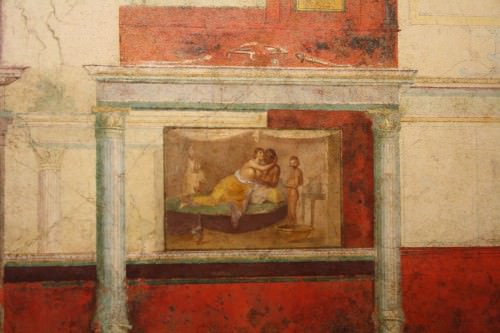
Roman Fresco, Villa of the Farnesina, Rome
Style II originated in Rome around 90 BCE and incorporated painted columns, often with an architrave and pediment acting as a frame to inner scenes, which themselves can be framed by columns. The paintings are given perspective and religious and cult scenes are particularly popular. Another feature of the style is the depiction of small framed paintings either side of the larger, more striking central scene. The House of Livia on the Palatine hill in Rome has excellent examples of this style.
In Style III, which appeared in the reign of Augustus, the architectural elements become more fantastic and are elaborately decorative. The dominance of black, red and yellow continues but greens and blues appear and more wall space is left plain.There is also a greater attention paid to symmetry rather than perspective. A fine example is the House of Lucretius Fronto at Pompeii.
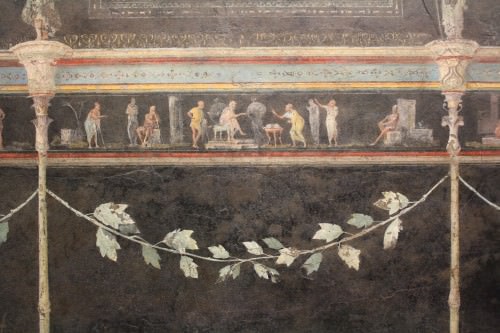
Roman Fresco, Villa of the Farnesina, Rome
The highly decorative Style IV is best seen at Pompeii where many of the villas were redecorated in the style following the earthquake of 62 CE. The House of the Vetti displays the characteristics of this style with large central panels; there is an increasing use of white for backgrounds, a greater attention to detail and perspective returns in the paintings which include more intricate decorative motifs, floral borders and friezes between panels.
Later developments in wall painting are more difficult to trace due to a lack of surviving examples and a general preference in later times for marble veneers and tempera painting which survives less well than true fresco. Elements of Style III and IV seem to continue but there is less use of the dado and the three-way division of walls is largely abandoned to allow for larger-scale single scenes which present larger-than-life figures. By the 3rd century CE one of the best sources of wall painting comes from Christian catacombs where scenes from both the Old and New Testament were popular such as Daniel in the lion's den, Jonah and the Whale and Christ's miracles. There was also a trend for dividing the wall and ceiling using stripes and lines against a white background.
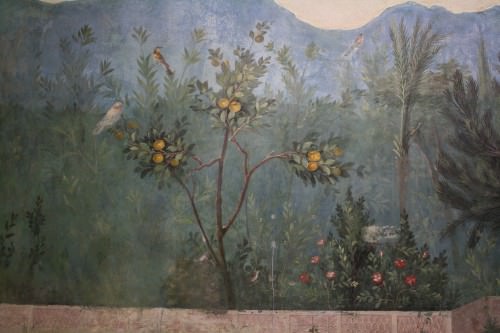
Garden Fresco, Livia's Villa, Rome
OUTSTANDING EXAMPLES
The triclinium or dining room from the 1st century BCE residence known as Livia's Villa (wife of Augustus) in Rome has a 360° panorama of an impressionistically rendered garden which runs around the room completely ignoring the corners. The impressive variety and luxuriance in the garden includes plants, flowers, fruit, laurel and palm trees, vines, birds and insects, all life-size and painted against a brilliant blue sky. Depth and perspective are cleverly achieved by rendering the subjects in finer detail the closer they are to the viewer whilst the background subjects are painted less distinctly. A low cane and wicker fence in the foreground completes the illusion that one is in a garden paradise rather than in a small claustrophobic room with no windows.
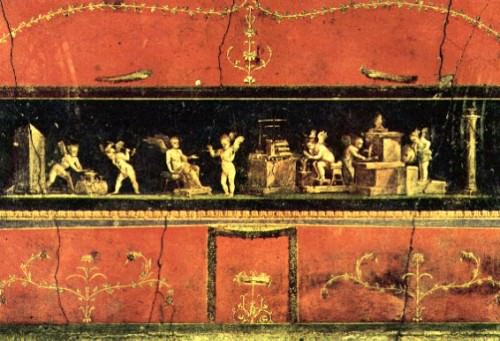
Cupid Frieze, House of the Vettii, Pompeii
The triclinium of the 1st century CE private villa known as the House of the Vetti in Pompeii has some of the most famous images from Roman wall painting. The rich red walls are divided by black bands and the frieze running above the dado depicts cupids and psychai involved in all kinds of activities such as religious rites, shooting arrows, racing in antelope-drawn chariots, selling flowers and perfumes and even working as goldsmiths, vintners and bakers. The whole run of scenes then culminates in a procession honouring Dionysos with goat-drawn wagons and the pastoral god Pan.
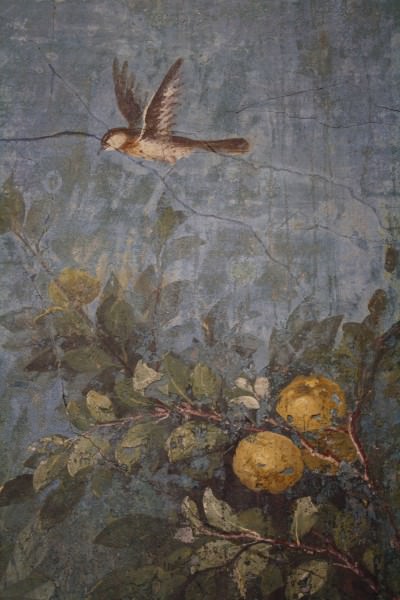
Fresco, Livia's Villa, Rome
CONCLUSION
Roman wall painting, then, has provided us with a rare glimpse of the artistic tastes and preferences of the Romans and the delicate frescoes which have miraculously survived the ravages of time allow us to not only see for ourselves the religious and cultural practices, the architecture, the industries, even the food of the Roman world but they also allow us to gaze at and admire the very same views that were likewise enjoyed by a people separated from us in time by twenty centuries.
LICENSE:
Article based on information obtained from these sources:with permission from the Website Ancient History Encyclopedia
Content is available under License Creative Commons: Attribution-NonCommercial-ShareAlike 3.0 Unported. CC-BY-NC-SA License